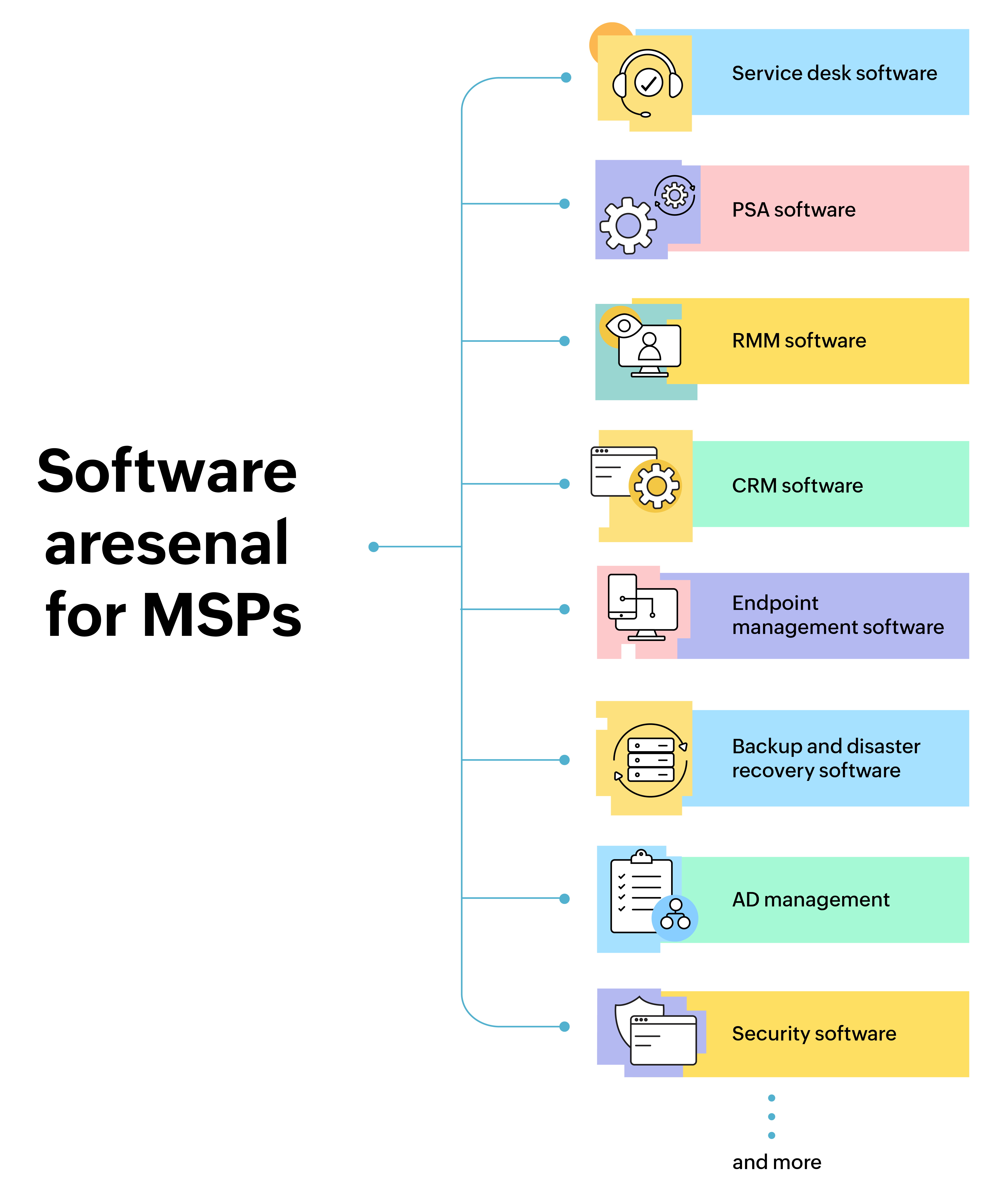

Unlock the ultimate blueprint for building your MSP business from the ground up.

Last updated on: May 14, 2024
Starting an MSP business can be challenging, but it doesn't have to be. Just like any journey, the first step is often the most important and daunting. A Chinese philosopher, Lao Tzu, once said, "The journey of a thousand miles begins with a single step." With the right preparation and guidance, anyone can make sure that first step is the right step, and start off their journey right to succeeding as an MSP business owner.
The MSP industry is estimated to be worth USD 275.5 billion today, and seeing the increasing demand for outsourced IT services, the managed services market is projected to reach USD 372.6 billion by 2028. In order to succeed in this industry, you should carefully consider all aspects before starting your business.
In this article, we will explore six essential steps to help you get started on this exciting venture:

Before starting an MSP business, it is important to conduct thorough research into the industry, market trends, and competitive landscape in the region. Identify a specific area to focus on that aligns with your business model and objectives, understand the services you can offer, the clients you want to target, and the resources you need.
Creating a business model canvas (a blueprint) of your business can help you understand the intricacies and details of the venture. For an example, have a look at the sample we have created specifically for a generic MSP business:
Table 1: Business model canvas for a generic managed service provider
The business model canvas is a very important tool to provide a visual representation of the key components of a business model. For budding MSPs, the business model canvas is especially important, as it provides a framework for creating a comprehensive business plan that can be used to attract investors and customers.

Your next step is obtaining the necessary licenses and permits. It is essential for operating your business in compliance with the law. The specific prerequisites may differ depending on your geographical location. Here's a breakdown of some common types of licenses and permits required based on different geographical locations:
General business licenses
Commercial/business registration
A basic registration as a business entity, such as sole proprietorship, partnership, or corporation, is a common requirement for any country.
Tax registration
Registration for relevant taxes, including income tax, sales tax, and payroll taxes, will be required and might vary according to different countries.
IT services license
Thisi s a specific licenses for businesses offering IT services like remote monitoring and management.
Data protection license
A license under data protection regulations like the GDPR (EU) or the CCPA (California) may be required if you handle sensitive data like personal information.
Cybersecurity license
Cybersecurity licenses for companies handling critical infrastructure data will be required for some regions (e.g., Singapore).
Telecom license
A telecom license may be required if your services involve managing VoIP or other telecommunications systems.
Additional permits and registrations
Business permits
Additional permits may be required by MSPs to run their business in jurisdiction of certain localities.
Environmental permits
Environmental permits may be necessary if your operations involve specific materials or processes.
Software vendor licenses
Vendor licenses may need to be obtained for commercial purposes depending on the software utilized to provide services.
US
The licensing requirements differ from state to state, and certain states may not require specific licenses for MSPs.
EU
Each EU member state has its own regulations for MSPs, so navigating through this requires specialized guidance.
Asia
IT services and data handling have been regulated through licensing systems in countries such as India and Singapore.
Table 2: Licenses and permits required for starting an MSP business
Beyond these, you will need to set up a business account, get insurance to protect your business from potential risks, and get legal and compliance advice from a lawyer and accountant to ensure you haven't missed anything.

The pricing structure for your MSP business should be customized based on the following factors:
It is essential to contemplate the value you bring, what your competitors are offering, and what it takes for you to deliver your services. While there are many MSP pricing models available, we have listed some widely used pricing models and their pros and cons for you to evaluate:
Per-device
A flat-fee billed per device, per month
Pros
Cons
Per-user
A flat-fee billed per user, per month
Pros
Cons
Tiered
Offerings are divided into different tiers based on cost and services involved in each tier
Pros
Cons
All-you-can-eat (AYCE)
A fixed price for a complete range of services
Pros
Cons
A la carte
A designated fee for each type of services
Pros
Cons
Value based
Charges based on the value of services offered
Pros
Cons
Table 3: MSP pricing models and their pros and cons
The pricing models you choose should meet the requirements of your customers. By utilizing a suitable pricing strategy, you can guarantee that you are delivering the best possible value for your services while also maximizing your profits.
After choosing an apt pricing model, the next step is to create a bundle of service offerings, or a service portfolio. To create your service portfolio, you can categorize your services based on various models that cater to different types of customers. For instance, an MSP service portfolio could include:
1. Core services: Start with essential offerings like IT service desk, endpoint management, and network monitoring.
2. Value-added services: Differentiate yourself with specialized services (like cloud migration, disaster recovery planning, or business continuity strategies).
3. Tiered packages: Offer different service levels (like bronze, silver, gold, and platinum) to cater to diverse customer needs and budgets.

To succeed as an MSP, your workforce is the key. You'll need a team of skilled technicians to provide quality IT support to your customers. If you're looking to start small, you can start with hiring just two to three techs and scale as you grow. For instance, if you're simply looking to offer help desk and service desk support, two to three techs will easily be able to handle customers with the right set of tools. However, some services may be more frequently used and would require a slightly bigger team to deal with the same number of customers.
Hiring employees or outsourcing services are both viable options for building a team. On average, MSP help desk technicians earn around $55K annually, so it's important to make sure personnel are paid well to reduce attrition, which is getting quite high (40-50%) in start-ups. Alternatively, if you're looking to start your MSP business as a partnership with a group of people (minimum of three) with knowledge in different facets of this industry, you may be able to start without hiring any technicians in the initial stage.
It is essential for technicians to be properly trained and possess the required skills to complete their assigned tasks and projects. Clear direction and expectations should be provided as well as feedback and recognition for a job well done. Additionally, having the right tools and resources available is critical to ensure technicians can complete their tasks on time and avoid SLA violations. Above all, a workforce that prioritizes customer service is crucial for achieving success as an MSP.
Creating an efficient marketing strategy for your MSP business is very important for achieving success. It should encompass a clear-cut approach to effectively reach your target audience, incorporating a combination of online and offline marketing techniques.

A buyer persona is a detailed representation of your ideal customer, providing insight into their specific needs, desires, and behaviors. It helps you gain a deeper understanding of your target audience and effectively tailor your marketing efforts to meet their preferences.
Understand the wants and needs of your ideal customer and craft content that speaks to them. Incorporate language and visuals that will be meaningful to your target audience, and ensure that your website is simple to navigate.


A successful marketing strategy for MSPs involves the right mix of these campaigns: content, email, and social media marketing.
Execution of these three campaigns are essential for reaching B2B customers and ensuring continuous inflow of organic traffic and lead generation.
SEO helps to increase your website's visibility to potential MSP customers when they search for the services you offer. It is the process of optimizing your website and content, using targeted keywords, creating backlinks, and more, so that your website ranks higher on search engine result pages.


Organize podcasts, webinars, and attend MSP-specific trade shows and events. These marketing activities will help with brand visibility, capture the mind-space of your potential customers, and ultimately work as a step in the direction of establishing you as a leader in your field.
It's the ultimate measure of any successful marketing strategy. It's always a number game; the more you track, the better you know what works and what doesn't. It will help you improvise, plan, and execute marketing strategies more effectively in future.

It is also important to develop a strong brand identity once you get going, as this will make your business more recognizable and memorable. Building a strong reputation for quality and reliability is also essential, as this will help you attract and retain clients.

You'll need to invest in the right tools and technology to manage your business and provide services to your clients. Your MSP tech ecosystem needs to be comprised of the right combination of software and hardware tools (see images 5 and 6) in their arsenal.

Image 5: Software arsenal for MSPs

Image 6: Hardware arsenal for MSPs
However, choosing the right solutions can be overwhelming with the vast array of options available. To help you navigate this process, here are some key things you need to keep in mind:
Before building your MSP tech stack, it's important to evaluate your requirements and budget. This involves focusing on your niche and determining your target client base and its specific needs, such as cybersecurity, cloud services, and network monitoring. These considerations will guide your technology choices. Additionally, it's important to prioritize core functionalities, such as PSA, ticketing, remote monitoring, patching, and reporting. Start with affordable, essential solutions and scale up as your business grows. When budgeting, consider both upfront costs and ongoing subscriptions.
When starting out as an MSP, it's crucial to prioritize the most essential tools. Here are some commonly required tools for MSPs to effectively kick-start their businesses:
When choosing tools for your business, remember to consider security, scalability, integration, and training and support. Give priority to tools with robust security measures and the ability to adapt and expand with your client base. Additionally, select solutions that seamlessly integrate with each other and your current systems, and allocate resources for training your team to ensure a successful implementation.
ServiceDesk Plus MSP is a comprehensive service desk solution for MSPs, providing a comprehensive platform with PSA and ITSM capabilities in a single, secure, scalable, and flexible package. With its AI-powered predictive capabilities, extensive automation options, and data-driven insights, MSPs can quickly address customer issues, make better decisions, and stay ahead of the competition. Plus, its reports and dashboards provide invaluable data-driven insights to monitor productivity and make informed decisions for your business.
See ServiceDesk Plus MSP in action Request a free demo![]()
With these points in mind, you're now ready to take that first step towards building your MSP business. And since starting an MSP business can be a challenging experience, we have created a guide to running a successful managed services business. This will help provide you with the tools to build your business from ground up.
Here's to building a new MSP business and succeeding at it.

Aditya Oswal is a product marketer at ManageEngine, A division of Zoho Corp., where he drives several marketing initiatives and contributes with marketing collaterals on all levels. He has authored guides on managed service providers (MSPs), PSA software, and field services management for MSPs in addition to managing various user education and thought leadership webinars addressing ITSM challenges experienced by enterprises worldwide. He specializes in organizing campaigns for product releases, user education programs, and more for ManageEngine's flagship ITSM products and shares a keen interest in managed services and the customer support industry.